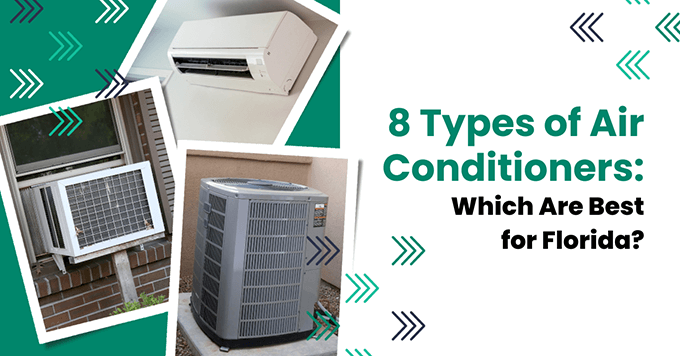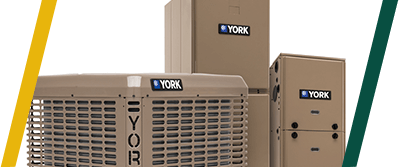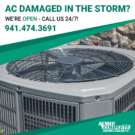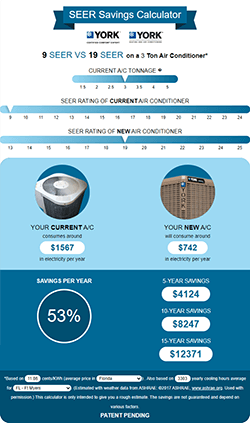
What type of air conditioner do you have in your home? According to a 2020 survey, 90% of Florida homes (66% of homes in the entire US) have central air conditioning. Is yours a split or a packaged system? Or, like 11% of Floridians, do you use some kind of single-room air conditioning system? Maybe you’re surprised to learn that there are so many types of air conditioners available.
In this post, we’ll walk you through eight types of residential air conditioners. We divided them into two main categories: central air conditioners and individual air conditioners. We also included a third category for other air conditioners that don’t fit into the first two groups. We’ll discuss their use cases, energy efficiency, and compare their cost. Finally, we’ll give you our recommendations on which types of air conditioners are best for Florida homes, and how you can use them in your home.
Central Air Conditioners
The two most common types of air conditioners, both in Florida and in the United States, fall under the category of central air conditioning. Central air conditioners cycle cool air to your entire home via a system of supply and return ducts and vents. Although there are other parts involved, the two main components of a central air conditioner are the condensing coil and evaporating coil. These are responsible for cooling the air and expelling heat using refrigerant.
All central air conditioners can be either straight cool systems or heat pumps (you can read more about heat pumps here). Also, they belong to one of two main types – split systems and packaged systems.
#1 Split System Central Air Conditioner
In a split system, there are two separate units housing the condensing coil and evaporator coil. The air handler, containing the evaporator coil, is located indoors. In most Florida homes, the air handler is installed in the garage or in an attic. The second unit, the condenser, contains the condensing coil and is located outdoors, generally beside the garage. You control the temperature via a thermostat on the wall inside the home.
Uses:
A split central air conditioning system is very common in both single- and multi-family residences in Florida. In fact, it’s the most common type of central air conditioning system in the USA.
Energy Efficiency:
The efficiency of split AC systems has improved in recent years, thanks to technological developments and government regulation. The national standard for the minimum energy efficiency rating underwent its most recent update in January 2023.
Cost:
Compared with other types of air conditioners, a split system central air conditioner is in the moderate to high price range. But the price of a split system varies depending on the size of the unit and how energy efficient it is. Homeowners can choose from less efficient models to save money upfront. On the flip side, you can opt for a more expensive high efficiency system and save money on electricity over time.
There are also add-ons like smart thermostats and zoning systems that add to the initial cost but increase potential energy savings. We should also mention that having a split system installed is more expensive than replacing an existing system, because you must factor in the cost of the ductwork.
#2 Packaged Central Air Conditioner
Packaged systems consist of a single unit that houses both the condensing and evaporating coils. This unit is normally located outside the home, or in some cases, on the roof. Like a split system, a packaged unit uses ducts to circulate the air, and an indoor thermostat controls the temperature.
Uses:
Packaged units are a good option – sometimes the only (whole-house) option – for homes where indoor space is limited. They are commonly found in mobile and manufactured homes.
Energy Efficiency:
Although there are more and less efficient systems available, packaged units do not have as wide a range of efficiency options as split systems. Also, the minimum standard efficiency rating for packaged units is lower than for split systems.
Cost:
Packaged units cost slightly less than split systems. The single-cabinet design makes them faster and less labor-intensive to install.
Individual Air Conditioners
This category encompasses systems used to cool individual rooms or areas of a home, rather than the entire house. In general, individual air conditioners are more popular in cooler climates, where air conditioning is only necessary for a short time each year. They are also popular in urban areas where outdoor space is limited, or where buildings are too old to have existing ductwork.
This may lead you to believe that individual air conditioners are not useful in most Florida homes. However, this is far from the truth. According to the survey we mentioned earlier, 90% percent of homes in Florida have central AC, but 11% use some form of individual air conditioning. These homes may use an individual AC unit either as a primary cooling system, or as a supplement to central AC.
#3 Ductless (Mini Split) Air Conditioners
As their name implies, ductless air conditioners do not use ducts to circulate air in your home. These units are also called mini splits because, like split system central air conditioners, they consist of an indoor and an outdoor unit. The indoor unit hangs on a wall, while the outdoor unit sits at ground level. Instead of ducts, the two units are connected via thin tubes and wires, fed through a small hole in the wall. A fan inside the indoor unit blows air into the room, and you use a small remote (or in some cases, a smartphone app) to control the temperature. Indoor and outdoor mini split units are each significantly smaller than their central split system counterparts.
Uses:
Ductless mini splits are becoming more common. While you can use them to cool an entire home (via multiple indoor units connected to one or more outdoor units), the most common use case for mini splits is single room cooling.
In Florida, where most homes have central air conditioning, ductless air conditioners can provide supplemental cooling. Rather than lowering the temperature in the whole house, you can adjust a ductless unit in to keep you cool in the kitchen while cooking, or in the bedroom as you sleep. Some areas of your home that don’t have existing ductwork, like a garage, a tool shed, or a new addition, could also benefit from a ductless air conditioner.
If aesthetics is important to you, mini split units are also nicer to look at than other types of individual air conditioners. Additionally, because they are wall-mounted, they don’t take away floor space.
Energy Efficiency:
Ductless air conditioners are very energy efficient, both because of their design and the ease of adjusting them to your specific temperature needs. Also, without ducts, there is less opportunity for energy waste. Air leakage through holes in ducts can account for up to 30% of a central air conditioner’s energy consumption.
Cost:
Ductless mini splits are more expensive than other types of individual air conditioners. However, mini split installation can be less expensive and less invasive than installing or extending ducts. Also, for most supplemental and single-room applications, a mini split will save you money on energy costs compared to most other options. To cool an entire typical Florida single-family home, though, it’s more cost-effective to replace your existing central air conditioner than to substitute it for multiple mini splits.
#4 Windows Air Conditioners
These self-contained units provide cooling to a single room. Window units are designed to be mounted through an open window. The front of the unit blows cool air into the room while the back expels warm air and drains condensation outside. A system of panels and brackets (normally included with the unit) secures the unit to the window frame and seals the edges.
Uses:
Apartments and other smaller spaces make the most frequent use of window AC units. Though not very common in Florida as a whole, you can find a higher concentration of window units in urban areas with old buildings that would be a challenge to retrofit for central air conditioning. You can also use a window unit for temporary or supplemental cooling.
Energy Efficiency:
Some window unit models are moderately energy efficient. Although, if it is not properly installed and sealed, air can escape to the outside, wasting energy. This is not a problem for ductless mini splits, since the hole to the outside is so small.
Cost:
Window units are popular in many areas of the country because of their low cost, easy DIY installation, and short-term applications. However, with the low price comes a moderate security risk. A person could gain entry to your home by dislodging the window unit and slipping in through the open window. The unit could also fall out of the window if not properly installed.
#5 Portable (Room) Air Conditioners
These small air conditioners are about the size of a mini fridge. As the name suggests, you can move them easily from room to room. The unit vents to the outside via a wide hose that connects to an open window. Included panels attach to the window frame via mounting brackets, sealing the area around the hose.
Uses:
Portable units are common in situations where AC needs are limited. Because of the relative ease of setup, they can also provide temporary or supplemental cooling.
Energy Efficiency:
Since their use cases are similar, it’s easiest to compare portable air conditioners with window units. In general, portable air conditioners are slightly less efficient than window units.
Cost:
Portable units are a bit more expensive than window units and, some claim, not as easy to install. Like window air conditioners, portable units present security concerns because of the open window.
#6 Through-the-Wall Air Conditioners
Like window units, through-the-wall air conditioners are contained in a single cabinet. The front side, with the fan and control panel, faces into the home, while the back side vents air and drains condensation directly to the outside. However, unlike a window AC, installation requires cutting a hole in the wall the same size as the unit.
Uses:
Though less popular than window units and ductless systems because of the invasive installation, these air conditioners provide an alternative option in cases where no ductwork exists. They also work as a supplemental cooling method. A more common type of through-the-wall unit called PTACs (Packaged Terminal Air Conditioners) are used in some hotel rooms and similar commercial buildings.
Energy Efficiency:
These units are less efficient than ductless air conditioners. Their efficiency is like that of a window unit.
Cost:
The price for a through-the-wall unit runs somewhere between a portable unit and a mini split system.
Other Air Conditioning Systems
There are two other types of air conditioners that don’t quite fit into the other categories. However, they’re still worth mentioning. Both types of air conditioners use an alternative energy source for cooling.
#7 Evaporative Cooling Systems (Swamp Coolers)
Evaporative air conditioners, also known as swamp coolers, can either be portable units or whole-house systems that function much the same as central air. The main difference between evaporative AC systems and other types of air conditioners is that evaporative systems don’t use refrigerant. Instead, in a modernized form of an ancient cooling method, a fan blows air across ice, through a damp pad, and into the room (or the ductwork in case of a whole-house unit).
Uses:
Evaporative cooling is an option for any type of residence, from an apartment to a mobile home, to a single-family dwelling. As already stated, they can be portable units or packaged units connected to your home via ducts. You can even make your own portable swamp cooler for camping or other outdoor uses. However, evaporative cooling has one huge disadvantage for Florida: it adds humidity to the air. Thus, these systems are better suited to arid environments.
Energy Efficiency:
Evaporative cooling is very energy efficient. In fact, according to Energy.gov, they use about one-quarter as much energy as a central air conditioner. However, because they use ice for cooling, the units need regular monitoring, refilling, and maintenance.
Cost:
Portable swamp coolers can be very inexpensive, especially if you make one yourself. Whole-house units can cost up to 50% less to install than traditional central split or packaged air conditioners.
#8 Geothermal Air Conditioners
Geothermal systems are heat pumps that provide heating and cooling to an entire home. Like other central air conditioning systems, they deliver cooled (or heated) air via ducts. The main geothermal unit is installed inside the home. The unit connects to a system of pipes that extend into the ground (ground-source system) or run out to a nearby pond, lake, or well (water-source system). To heat or cool your home, refrigerant circulating through the pipes either draws heat from, or expels heat to, the ground or water.
Uses:
Geothermal systems are gaining in popularity because of their energy efficiency. There are options available for both residential and commercial properties. However, they require enough land or a nearby water source to install the ground or water piping systems. This makes residential installation impossible in some cases.
Energy Efficiency:
Geothermal heat pumps are more energy efficient than most other types of central HVAC systems. This includes even including air source heat pumps. Only evaporative cooling systems might use less electricity.
Cost:
Geothermal is a high-cost option, especially because of the installation, compared with other types of central air conditioning. Anyone considering a Geothermal system should weigh the short-term cost against the potential for long-term energy efficiency payback.
Summary and Recommendations
So, what type of air conditioner is best for the typical Florida home? Out of the eight types of air conditioners we covered, here are our recommendations:
- Split system central air conditioners: Recommended for most Florida homes. Here, you will get the best balance between price, energy efficiency, and comfort.
- Packaged central air conditioners: Recommended for Florida homes where a split system is not an option (e.g. for manufactured and mobile homes).
- Ductless mini split air conditioners: Recommended for small spaces, like garages, workshops, additions, lanais, and more. Plus, mini splits systems are an excellent choice as a supplement to a central air conditioner.
- Window air conditioners: Not recommended for Florida homes, except for temporary cooling needs. Mini splits offer better security, aesthetics, and energy efficiency, even though they are more expensive to install.
- Portable air conditioners: Only recommended as a temporary cooling solution (e.g. when the central AC system is broken).
- Through-the-wall air conditioners: Not recommended for Florida, especially since better solutions exist that don’t involve cutting a giant hole in the wall. In most residential cases, we recommend a mini split system over a through-the-wall unit.
- Evaporative air conditioners (swamp coolers): Not recommended for Florida because of the humidifying effect. Plus, they are high maintenance. A swamp cooler can come in handy as a temporary cooling solution, or for outdoor uses like camping.
- Geothermal air conditioners (heat pumps): Despite the energy savings they offer, Geothermal is not an option for most homes because the installation can be expensive, invasive, and in some cases impossible.
Need A New Air Conditioner?
Kobie Complete installs central air conditioners (including split and packaged systems) as well as ductless mini split systems in Florida homes located in Sarasota County and Charlotte County. Are you in our service area? Fill out the form below or call us at (941) 474-3691 to get a free, no-obligation quote on a new air conditioner.
Sources:
“Nearly 90% of U.S. households used air conditioning in 2020”, U.S. Energy Information Administration, May 31, 2022, https://www.eia.gov/todayinenergy/detail.php?id=52558. Accessed October 3, 2023.
“Highlights for air conditioning in U.S. homes by state, 2020”, U.S. Energy Information Administration, March 2023, https://www.eia.gov/consumption/residential/data/2020/state/pdf/State%20Air%20Conditioning.pdf. Accessed October 3, 2023.
“How a Packaged System Works”, Goodman Air Conditioning & Heating, https://www.goodmanmfg.com/resources/heating-cooling-101/how-a-packaged-system-works. Accessed September 19, 2023.
“8 Types of Air Conditioners, Plus the Pros and Cons of Each”, Timothy Dale, Better Homes & Gardens, July 19, 2022, https://www.bhg.com/home-improvement/advice/expert-advice/types-of-air-conditioners/. Accessed September 19, 2023.
“Facts About AC Ownership In The 15 Most Populated U.S. Cities”, Ana Durani, Forbes, June 28, 2023, https://www.forbes.com/home-improvement/hvac/most-populated-us-cities-ac-ownership/ , Accessed September 19, 2023.
“Why about a quarter of US households are stuck with ugly and loud window AC units”, Sophie Bearman, CNBC, July 26, 2018, https://www.cnbc.com/2018/07/26/ac-units-central-air-summer-window-new-york-america.html Accessed September 16, 2023.
“Do Portable Air Conditioners Work? (2023)”, Amanda Lutz, Architectural Digest, March 15, 2023, https://www.architecturaldigest.com/reviews/hvac/do-portable-air-conditioners-work. Accessed October 3, 2023.
“Swamp Coolers Are a Cheap AC Alternative for Dry Climates. Here’s What to Know Before You Buy.”, Thom Dunn, New York Times Wirecutter, September 6, 2023. https://www.nytimes.com/wirecutter/blog/do-swamp-coolers-work/. Accessed October 3, 2023.
“Evaporative Coolers”, Energy Saver, U.S. Department of Energy, https://www.energy.gov/energysaver/evaporative-coolers. Accessed October 3, 2023.










